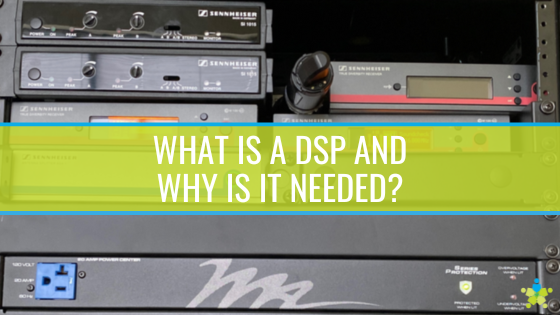Audio-visual conferencing has become one of the most popular and cost-effective methods of communicating in this modern technological age. However, conferencing and collaborating cannot work properly without the right components, such as a DSP, or digital signal processor. While the DSP is an integral part of any AV system, many businesses and schools wonder exactly what is a DSP and why is it needed?For now, suffice it to say that for an audio-visual system to be at its best, it also requires an excellent digital signal processor. To find one that best fits your organization’s unique needs, it is critical to have a deeper understanding of what a DSP is and why it is needed. So, lets dive in.
What Is A DSP?
DSP is an acronym for digital signal processor. The purpose of a DSP is to take digitized audio, video, position, pressure, and temperature and then manipulate them mathematically by subtracting, adding, etc.For example, a sound from the outside world, such as music can be transmitted through a receiver and then converted to a digital signal that can read like a series of 0s and 1s. The DSP can save this complex code to memory, be manipulated, and then converted back to an analog signal for use.A good digital signal processor is programmable and can perform all these functions quite accurately and at a relatively high speed. It can also essentially help improve the quality of a sound. To do all of these things it takes several key elements working together.There are four main components that make up a digital signal processor, including:
- Compute Engine. This part of the DSP is responsible for handling mathematic processes.
- Data Memory. Much like a computer, this is where information is stored as it awaits processing.
- Input/Output. This component provides connectivity functions.
- Program Memory. Instead of information storage, this area stores programs used to process data.
Most audio-visual systems will at the very least have an audio DSP which assists with audio functions like compression signals, equalization, limiting, and volume. It is especially common to find this piece of equipment in auditoriums and conference rooms, but it can also be used in conjunction with a computer to regulate telephones and video compression.
Why You Need A DSP
Without signal processing for an audio system, sound adjustments can only go so far. Think amplifiers for example. While this can change the sound and make sure it is heard, that system simply cannot provide the quality, resolution, or adjustability that a DSP offers.To truly value a DSP’s capabilities, think about your next business or professional development conference and auditorium lecture or performance. Now consider all the people that your words and messages will be reaching in that space. Then ask yourself if it is more important that they hear those sounds or really be able to listen with clarity. That is the difference a digital signal processor can make.
Finding the Right Digital Signal Processor
Now that you understand the function of having a working DSP for your AV needs, the next obstacle becomes finding the right digital signal processor. While there are a number of different styles and brands available, some of the most popular options include:
- Biamp TesiraFORTE Series: This series of DSP products features multiple analog and network audio connection points and either 4 (X400), 8 (X800), or 16 (X1600) channels of Acoustic Echo Cancellation (AEC) depending on the model.
- Crestron DSP 860 (8x6): Known for its best-in-class audio and configurability, this DSP is designed to deliver quality sound in a conference room, auditorium, and other meeting and performance venues. It offers configurability, easier implementation, intuitive software, system integration for rapid programming, eight mic/line inputs, and can work off of Ethernet or USB.
- Crestron DSP 1280 (12x8): This model offers many of the same features as the Crestron DSP 860 but can be a step up in that it offers twelve mic/line inputs.
- Crestron DSP 1281 (12x8): This product features user friendly implementation, customizable input and output, intuitive software, twelve mic/line inputs, and internal universal power supply. It can work off of USB or Ethernet.
- Extron DMP Plus Series: This series includes the DMP 128 Flex Plus, XMP 240, DMP 64 Plus, and DMP 128 Plus. Each model offers a variety of different DSP functions.
- Extron DMP Series: This series includes DMP 44 LC, DMP 64, DMP 128 C P, DMP 128 C P AT, and DMP 128. Each model in the series offers a different range of DSP capabilities.
- Extron AXP Dante Series: This series includes the AXP 64 C AT and the AXP 50 C AT. These audio expansion processor models may integrate remote microphones to a Dante enabled audio system.
If your school or business has an audio-visual conferencing system that is less than crystal clear, consider the positive impacts a DSP could have on communication and collaboration.
To read about a DSP in action, click here to check out how a well designed DSP elevated the audio and video conferencing for a mortgage company in Texas.



